Effects of Feeding Reduced Protein Diets on Milk Quality, Nitrogen Balance and Rumen Microbiota in Lactating Goats
Simple Summary
Abstract
1. Introduction
2. Materials and Methods
2.1. Animal, Experimental Design and Management
2.2. Dry Matter Intake and Milk Yield
2.3. N Balance and Sample Collection
2.4. Laboratory Analysis
2.4.1. N Metabolism
2.4.2. Milk Component
2.4.3. Microbiota Structure
2.5. Calculations and Statistical Analysis
3. Results
3.1. Dry Matter Intake, Milk Yield and Feed Efficiency
3.2. Milk Composition and Content
3.3. N Balance
3.4. Bacterial Richness and Diversity
3.5. Ruminal Microbial Differences at the Phylum and Genus Level
3.6. Correlation
4. Discussion
5. Conclusions
Author Contributions
Funding
Institutional Review Board Statement
Informed Consent Statement
Data Availability Statement
Acknowledgments
Conflicts of Interest
Abbreviations
| ADF | Acid detergent fiber |
| CON | Control group, 15.82% of protein level |
| CP | Crude protein |
| DMI | Dry matter intake |
| FPCM | Fat and protein corrected milk |
| IBW | Initial average body weight |
| NDF | Neutral detergent fiber |
| OTUs | Operational taxonomic units |
| PCA | Principal component analysis |
| QIIME2 | Quantitative insights into microbial ecology |
| R2 | 13.85% of protein level |
| R4 | 11.86% of protein level |
| R6 | 9.84% of protein level |
| R8 | 7.85% of protein level |
Appendix A
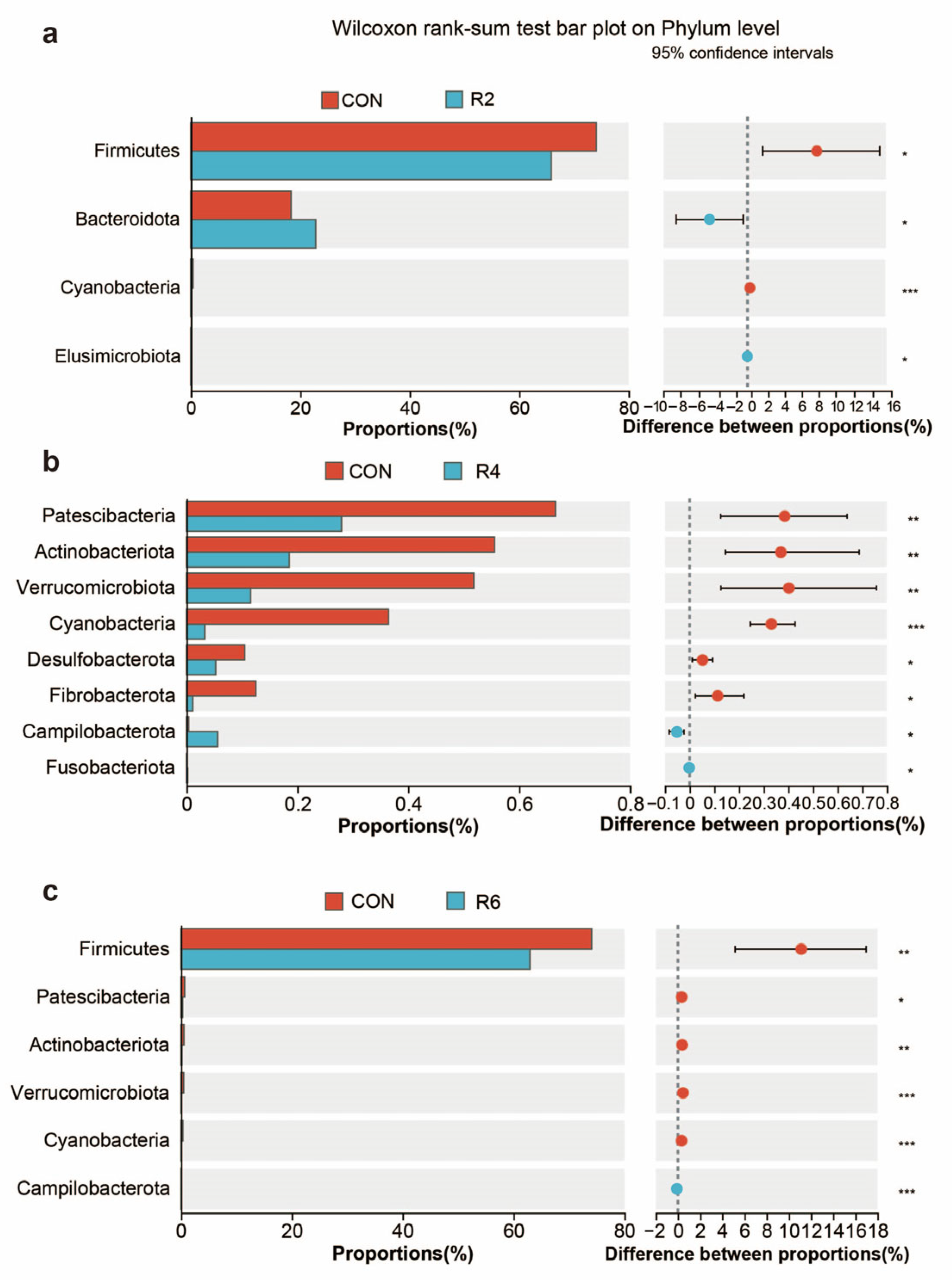
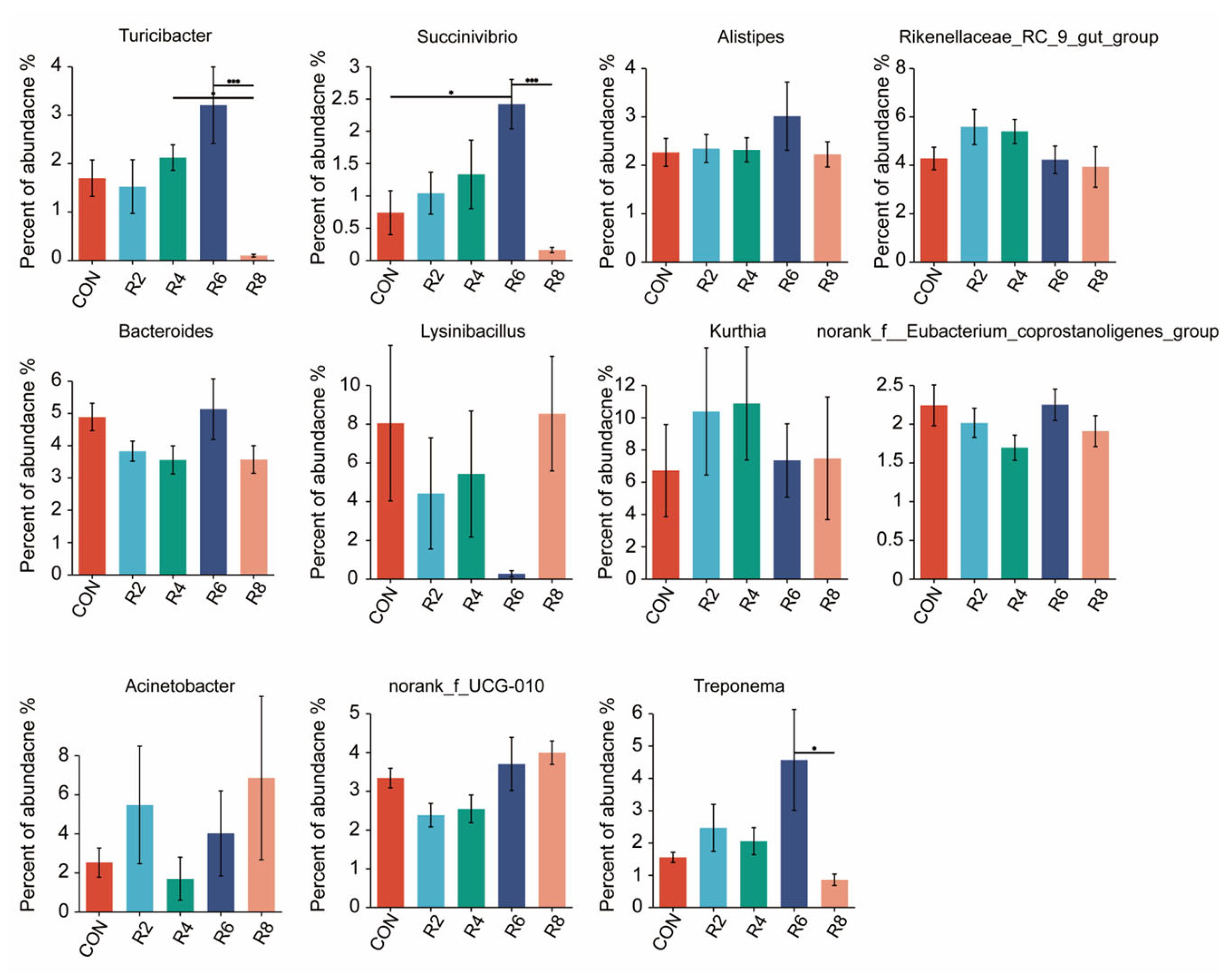
References
- Erickson, M.G.; Barros, T.; Aguerre, M.J.; Olmos Colmenero, J.J.; Bertics, S.J.; Wattiaux, M.A. Reducing dietary crude protein: Effects on digestibility, nitrogen balance, and blood metabolites in late-lactation holstein cows. J. Dairy Sci. 2024, 107, 4394–4408. [Google Scholar] [CrossRef] [PubMed]
- Sinclair, K.; Garnsworthy, P.; Mann, G.; Sinclair, L. Reducing dietary protein in dairy cow diets: Implications for nitrogen utilization, milk production, welfare and fertility. Animal 2014, 8, 262–274. [Google Scholar] [CrossRef] [PubMed]
- Kabasakal Cetin, A.; Dasgin, H.; Gülec, A.; Onbasilar, İ.; Akyol, A. Maternal low quality protein diet alters plasma amino acid concentrations of weaning rats. Nutrients 2015, 7, 9847–9859. [Google Scholar] [CrossRef] [PubMed]
- Apelo, S.A.; Bell, A.; Estes, K.; Ropelewski, J.; De Veth, M.; Hanigan, M. Effects of reduced dietary protein and supplemental rumen-protected essential amino acids on the nitrogen efficiency of dairy cows. J. Dairy Sci. 2014, 97, 5688–5699. [Google Scholar] [CrossRef]
- Zhu, W.; Xu, W.; Wei, C.; Zhang, Z.; Jiang, C.; Chen, X. Effects of decreasing dietary crude protein level on growth performance, nutrient digestion, serum metabolites, and nitrogen utilization in growing goat kids (Capra. hircus). Animals 2020, 10, 151. [Google Scholar] [CrossRef]
- Zhang, X.X.; Li, Y.X.; Tang, Z.R.; Sun, W.Z.; Wu, L.T.; An, R.; Chen, H.Y.; Wan, K.; Sun, Z.H. Reducing protein content in the diet of growing goats: Implications for nitrogen balance, intestinal nutrient digestion and absorption, and rumen microbiota. Animal 2020, 14, 2063–2073. [Google Scholar] [CrossRef]
- Liu, E.; VandeHaar, M.J. Low dietary protein resilience is an indicator of the relative protein efficiency of individual dairy cows. J. Dairy Sci. 2020, 103, 11401–11412. [Google Scholar] [CrossRef]
- Chowdhury, M.; Wilkinson, R.; Sinclair, L. Feeding lower-protein diets based on red clover and grass or alfalfa and corn silage does not affect milk production but improves nitrogen use efficiency in dairy cows. J. Dairy Sci. 2023, 106, 1773–1789. [Google Scholar] [CrossRef]
- Gebeyew, K.; Chen, W.; Yan, Q.; He, Z.; Tan, Z. Growth of pancreas and intestinal enzyme activities in growing goats: Influence of a low-protein diet. Agriculture 2021, 11, 1155. [Google Scholar] [CrossRef]
- Chobtang, J.; Intharak, K.; Isuwan, A. Effects of dietary crude protein levels on nutrient digestibility and growth performance of thai indigenous male goats. Songklanakarin J. Sci. Technol. 2009, 31, 591–596. [Google Scholar]
- Atiba, E.M.; Sayre, B.; Temu, V.W. Effects of dietary protein supplementation on the performance and noncarcass components of goats artificially infected with haemonchus contortus. Sci. Lett. 2016, 4, 124–130. [Google Scholar]
- Xie, M.; Jiang, Y.; Tang, J.; Wen, Z.; Zhang, Q.; Huang, W.; Hou, S. Effects of low-protein diets on growth performance and carcass yield of growing white pekin ducks. Poult. Sci. 2017, 96, 1370–1375. [Google Scholar] [CrossRef] [PubMed]
- Wu, Y.; Li, B.; Li, L.; Mitchell, S.E.; Green, C.L.; D’Agostino, G.; Wang, G.; Wang, L.; Li, M.; Li, J.; et al. Very-low-protein diets lead to reduced food intake and weight loss, linked to inhibition of hypothalamic mtor signaling, in mice. Cell Metab. 2021, 33, 1264–1266. [Google Scholar] [CrossRef]
- Rapetti, L.; Galassi, G.; Rota Graziosi, A.; Crovetto, G.M.; Colombini, S. The effects of substituting dietary soybean meal with maize grain on milk production in dairy goats. Animals 2020, 10, 299. [Google Scholar] [CrossRef]
- Guo, H.; Li, B.; Gao, M.; Li, Q.; Gao, Y.; Dong, N.; Liu, G.; Wang, Z.; Gao, W.; Chen, Y.; et al. Dietary nutritional level affects intestinal microbiota and health of goats. Microorganisms 2022, 10, 2322. [Google Scholar] [CrossRef]
- Henderson, G.; Cox, F.; Ganesh, S.; Jonker, A.; Young, W.; Janssen, P.H. Rumen microbial community composition varies with diet and host, but a core microbiome is found across a wide geographical range. Sci. Rep. 2015, 5, 14567. [Google Scholar] [CrossRef]
- Kulpys, J.; Paulauskas, E.; Pilipavicius, V.; Stankevicius, R. Influence of cyanobacteria arthrospira (spirulina) platensis biomass additive towards the body condition of lactation cows and biochemical milk indexes. Agron. Res. 2009, 7, 823–835. [Google Scholar]
- National Research Council. Nutrient Requirements of Small Ruminants: Sheep, Goats, Cervids, and New World Camelids; The National Academies Press: Washington, DC, USA, 2007; p. 384. [Google Scholar]
- Battelli, M.; Colombini, S.; Crovetto, G.M.; Galassi, G.; Abeni, F.; Petrera, F.; Manfredi, M.T.; Rapetti, L. Condensed tannins fed to dairy goats: Effects on digestibility, milk production, blood parameters, methane emission, and energy and nitrogen balances. J. Dairy Sci. 2024, 107, 3614–3630. [Google Scholar] [CrossRef]
- Lascano, G.J.; Heinrichs, A.J. Effects of feeding different levels of dietary fiber through the addition of corn stover on nutrient utilization of dairy heifers precision-fed high and low concentrate diets. J. Dairy Sci. 2011, 94, 3025–3036. [Google Scholar] [CrossRef]
- Yang, C.-M.; Chang, C.; Huang, S.-C.; Chang, T. Effect of lasalocid on growth, blood gases, and nutrient utilization in dairy goats fed a high forage, low protein diet. J. Dairy Sci. 2003, 86, 3967–3971. [Google Scholar] [CrossRef]
- Toral, P.G.; Bernard, L.; Belenguer, A.; Rouel, J.; Hervás, G.; Chilliard, Y.; Frutos, P. Comparison of ruminal lipid metabolism in dairy cows and goats fed diets supplemented with starch, plant oil, or fish oil. J. Dairy Sci. 2016, 99, 301–316. [Google Scholar] [CrossRef] [PubMed]
- Latimer, G., Jr. Official Methods of Analysis of AOAC International; AOAC International: Gaithersburg, MD, USA, 2016. [Google Scholar]
- Yu, Y.; Zi, Y.; Fu, R.; Fu, B.; Li, C.; Lv, Y.; Li, Z.; Wang, H.; Leng, J. Effects of dietary energy levels on microorganisms and short-chain fatty acids of rumen and tight junction proteins in honghe yellow cattle. Front. Microbiol. 2024, 15, 1335818. [Google Scholar] [CrossRef] [PubMed]
- Bolyen, E.; Rideout, J.R.; Dillon, M.R.; Bokulich, N.A.; Abnet, C.C.; Al-Ghalith, G.A.; Alexander, H.; Alm, E.J.; Arumugam, M.; Asnicar, F.; et al. Reproducible, interactive, scalable and extensible microbiome data science using qiime 2. Nat. Biotechnol. 2019, 37, 852–857. [Google Scholar] [CrossRef] [PubMed]
- Shaphiro, S.; Wilk, M. An analysis of variance test for normality. Biometrika 1965, 52, 591–611. [Google Scholar] [CrossRef]
- Law, R.; Young, F.; Patterson, D.; Kilpatrick, D.; Wylie, A.; Mayne, C. Effect of dietary protein content on animal production and blood metabolites of dairy cows during lactation. J. Dairy Sci. 2009, 92, 1001–1012. [Google Scholar] [CrossRef]
- Barros, T.; Quaassdorff, M.; Aguerre, M.; Colmenero, J.O.; Bertics, S.; Crump, P.; Wattiaux, M. Effects of dietary crude protein concentration on late-lactation dairy cow performance and indicators of nitrogen utilization. J. Dairy Sci. 2017, 100, 5434–5448. [Google Scholar] [CrossRef]
- Liu, E.; VandeHaar, M.J. Relationship of residual feed intake and protein efficiency in lactating cows fed high- or low-protein diets. J. Dairy Sci. 2020, 103, 3177–3190. [Google Scholar] [CrossRef]
- Goatcher, W.D. A Comparison of Taste Responses in Pygmy Goats, Normal Goats, Sheep and Cattle. Ph.D. Thesis, Oregon State University, Corvallis, OR, USA, 1969. [Google Scholar]
- Russo, N.; Floridia, V.; D’Alessandro, E.; Lopreiato, V.; Pino, A.; Chiofalo, V.; Caggia, C.; Liotta, L.; Randazzo, C.L. Influence of olive cake dietary supplementation on fecal microbiota of dairy cows. Front. Microbiol. 2023, 14, 1137452. [Google Scholar] [CrossRef]
- Alstrup, L.; Weisbjerg, M.R.; Hymøller, L.; Larsen, M.K.; Lund, P.; Nielsen, M.O. Milk production response to varying protein supply is independent of forage digestibility in dairy cows. J. Dairy Sci. 2014, 97, 4412–4422. [Google Scholar] [CrossRef]
- Giallongo, F.; Harper, M.T.; Oh, J.; Lopes, J.C.; Lapierre, H.; Patton, R.A.; Parys, C.; Shinzato, I.; Hristov, A.N. Effects of rumen-protected methionine, lysine, and histidine on lactation performance of dairy cows. J. Dairy Sci. 2016, 99, 4437–4452. [Google Scholar] [CrossRef]
- Arieli, A.; Sasson-Rath, R.; Zamwel, S.; Mabjeesh, S. Effect of dietary protein and rumen degradable organic matter on milk production and efficiency in heat-stressed goats. Livest. Prod. Sci. 2005, 96, 215–223. [Google Scholar] [CrossRef]
- Van den Bossche, T.; Goossens, K.; Ampe, B.; Haesaert, G.; De Sutter, J.; De Boever, J.L.; Vandaele, L. Effect of supplementing rumen-protected methionine, lysine, and histidine to low-protein diets on the performance and nitrogen balance of dairy cows. J. Dairy Sci. 2023, 106, 1790–1802. [Google Scholar] [CrossRef] [PubMed]
- Cantalapiedra-Hijar, G.; Peyraud, J.L.; Lemosquet, S.; Molina-Alcaide, E.; Boudra, H.; Nozière, P.; Ortigues-Marty, I. Dietary carbohydrate composition modifies the milk n efficiency in late lactation cows fed low crude protein diets. Animal 2014, 8, 275–285. [Google Scholar] [CrossRef] [PubMed]
- Atti, N.; Rouissi, H.; Mahouachi, M. The effect of dietary crude protein level on growth, carcass and meat composition of male goat kids in tunisia. Small Rumin. Res. 2004, 54, 89–97. [Google Scholar] [CrossRef]
- Negesse, T.; Rodehutscord, M.; Pfeffer, E. The effect of dietary crude protein level on intake, growth, protein retention and utilization of growing male saanen kids. Small Rumin. Res. 2001, 39, 243–251. [Google Scholar] [CrossRef]
- Zhou, J.; Guo, Y.; Kang, J.; Degen, A.; Titgemeyer, E.; Jing, X.; Wang, W.; Shang, Z.; Li, Z.; Yang, G. Tibetan sheep require less energy intake than small-tailed han sheep for n balance when offered a low protein diet. Anim. Feed Sci. Technol. 2019, 248, 85–94. [Google Scholar] [CrossRef]
- Schloss, P.D.; Westcott, S.L.; Ryabin, T.; Hall, J.R.; Hartmann, M.; Hollister, E.B.; Lesniewski, R.A.; Oakley, B.B.; Parks, D.H.; Robinson, C.J. Introducing mothur: Open-source, platform-independent, community-supported software for describing and comparing microbial communities. Appl. Environ. Microbiol. 2009, 75, 7537–7541. [Google Scholar] [CrossRef]
- Zhu, L.; Jian, X.; Zhou, B.; Liu, R.; Muñoz, M.; Sun, W.; Xie, L.; Chen, X.; Peng, C.; Maurer, M.; et al. Gut microbiota facilitate chronic spontaneous urticaria. Nat. Commun. 2024, 15, 112. [Google Scholar] [CrossRef]
- Belanche, A.; Arturo-Schaan, M.; Leboeuf, L.; Yáñez-Ruiz, D.; Martín-García, I. Early life supplementation with a natural blend containing turmeric, thymol, and yeast cell wall components to optimize rumen anatomical and microbiological development and productivity in dairy goats. J. Dairy Sci. 2023, 106, 4634–4649. [Google Scholar] [CrossRef]
- Hernández, R.; Chaib De Mares, M.; Jimenez, H.; Reyes, A.; Caro-Quintero, A. Functional and phylogenetic characterization of bacteria in bovine rumen using fractionation of ruminal fluid. Front. Microbiol. 2022, 13, 813002. [Google Scholar] [CrossRef]
- Lange, M.; Silva, L.; Zambom, M.; Soder, K.; Brito, A. Feeding alfalfa-grass or red clover–grass mixture baleage: Effect on milk yield and composition, ruminal fermentation and microbiota taxa relative abundance, and nutrient utilization in dairy cows. J. Dairy Sci. 2024, 107, 2066–2086. [Google Scholar] [CrossRef] [PubMed]
- Li, Q.; Tu, Y.; Ma, T.; Cui, K.; Zhang, J.; Diao, Q.; Bi, Y. Effects of two feeding patterns on growth performance, rumen fermentation parameters, and bacterial community composition in yak calves. Microorganisms 2023, 11, 576. [Google Scholar] [CrossRef] [PubMed]
- Ma, Z.Z.; Cheng, Y.Y.; Wang, S.Q.; Ge, J.Z.; Shi, H.P.; Kou, J.C. Positive effects of dietary supplementation of three probiotics on milk yield, milk composition and intestinal flora in sannan dairy goats varied in kind of probiotics. J. Anim. Physiol. Anim. Nutr. 2020, 104, 44–55. [Google Scholar] [CrossRef] [PubMed]
- Cunha, C.S.; Veloso, C.M.; Marcondes, M.I.; Mantovani, H.C.; Tomich, T.R.; Pereira, L.G.R.; Ferreira, M.F.; Dill-McFarland, K.A.; Suen, G. Assessing the impact of rumen microbial communities on methane emissions and production traits in holstein cows in a tropical climate. Syst. Appl. Microbiol. 2017, 40, 492–499. [Google Scholar] [CrossRef]
- Dong, J.; Liu, Y.; Li, S.; Sun, Z.; Chen, X.; Wang, D.; Qin, G.; Zhang, X.; Aschalew, N.D.; Wang, T.; et al. The physiological dissimilarities of holstein dairy cows with different milk yields. Vet. Med. Sci. 2023, 9, 429–442. [Google Scholar] [CrossRef]
- Jiang, X.; Xu, H.; Ma, G.; Sun, Y.; Li, Y.; Zhang, Y. Digestibility, lactation performance, plasma metabolites, ruminal fermentation, and bacterial communities in holstein cows fed a fermented corn gluten-wheat bran mixture as a substitute for soybean meal. J. Dairy Sci. 2021, 104, 2866–2880. [Google Scholar] [CrossRef]

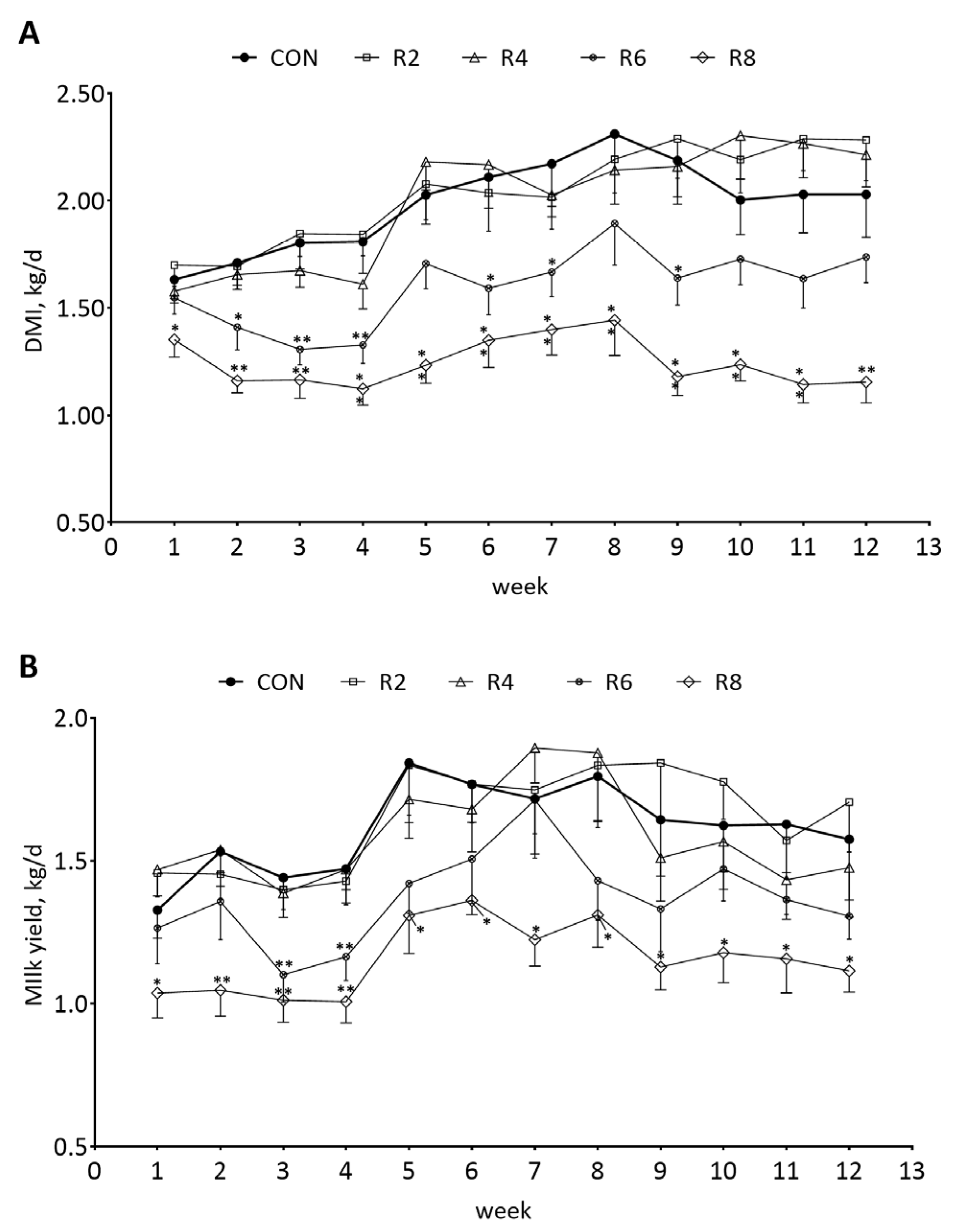
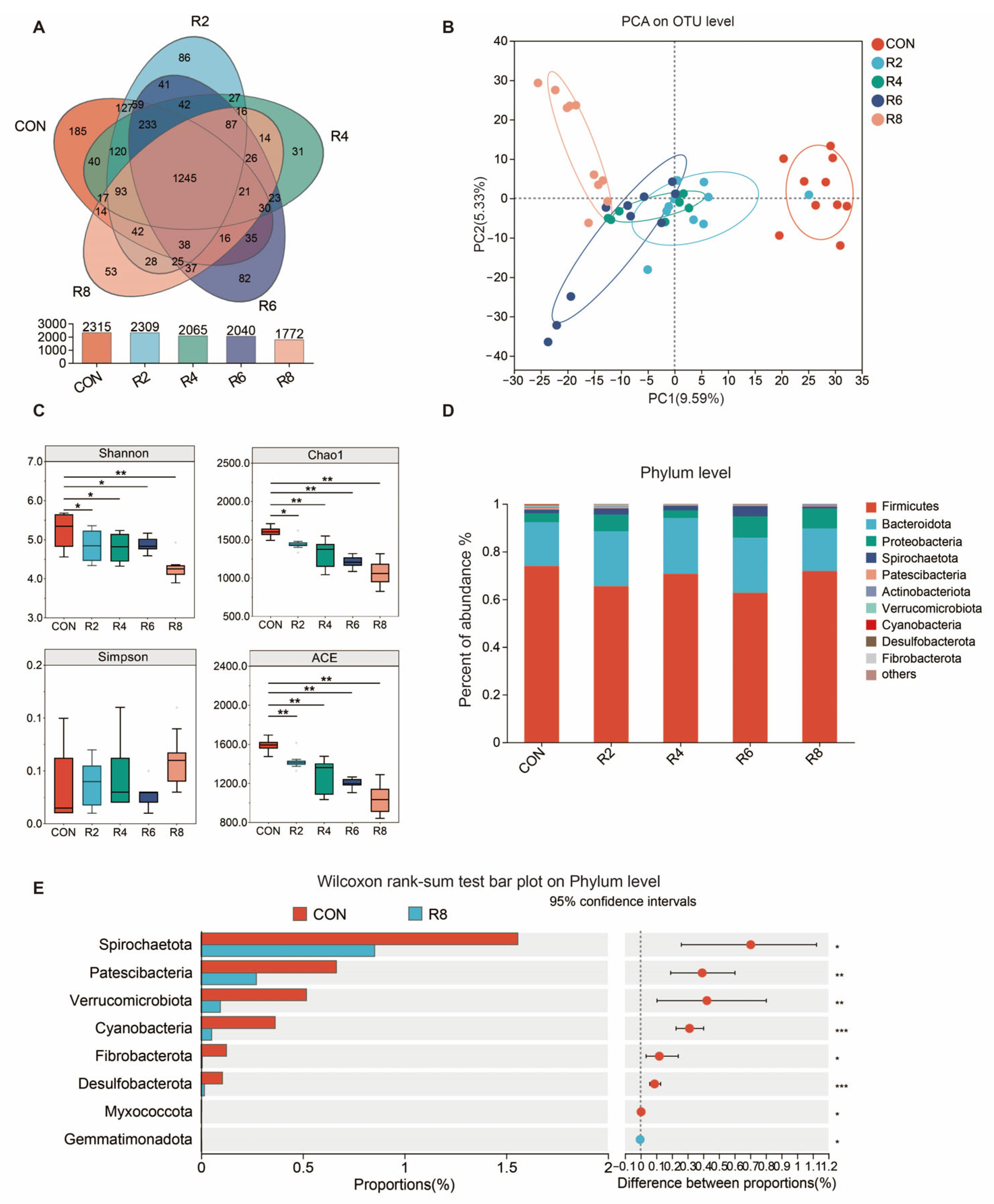
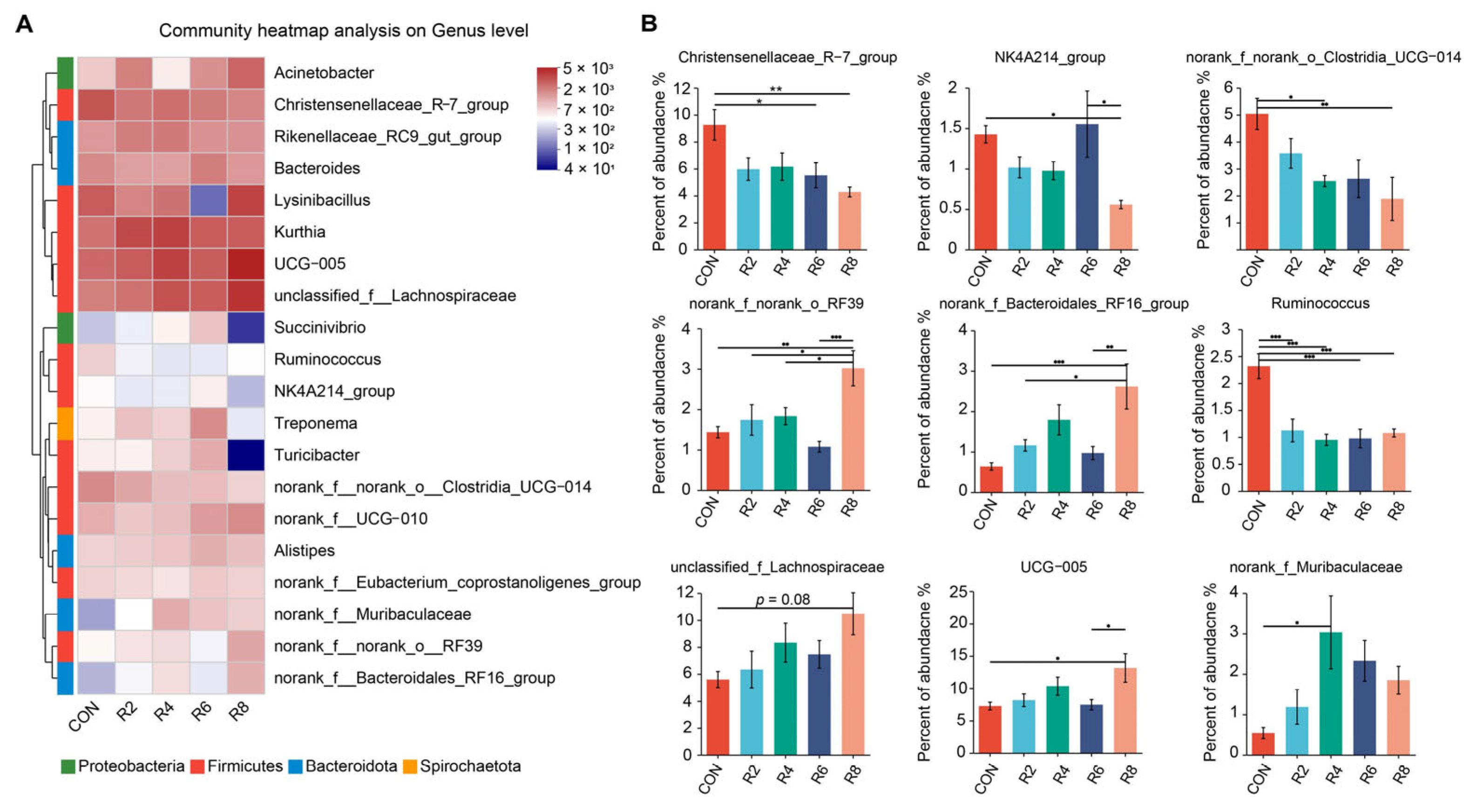

| Items | Diets 1 | ||||
|---|---|---|---|---|---|
| CON | R2 | R4 | R6 | R8 | |
| Ingredients (%) | |||||
| Corn silage | 40.46 | 41.33 | 41.21 | 42.14 | 40.14 |
| Rice straw | 9.54 | 8.67 | 8.79 | 7.86 | 9.86 |
| Corn | 22.35 | 26.68 | 31.28 | 35.48 | 38.84 |
| Corn starch | 2.81 | 2.54 | 2.15 | 1.45 | 1.21 |
| Wheat bran | 1.03 | 1.43 | 1.68 | 1.92 | 2.00 |
| Soybean meal | 16.35 | 12.55 | 8.98 | 5.91 | 3.25 |
| Rapeseed meal | 2.61 | 2.34 | 1.75 | 1.54 | 1.22 |
| Soybean oil | 1.65 | 1.24 | 0.94 | 0.48 | 0.12 |
| NaCl | 0.50 | 0.50 | 0.50 | 0.50 | 0.50 |
| Mineral/vitamin premix 2 | 1.00 | 1.00 | 1.00 | 1.00 | 1.00 |
| Calcium carbonate | 1.33 | 1.33 | 1.31 | 1.31 | 1.45 |
| Monocalcium phosphate | 0.37 | 0.39 | 0.41 | 0.41 | 0.41 |
| Total | 100.00 | 100.00 | 100.00 | 100.00 | 100.00 |
| Nutrient levels (%) 3 | |||||
| ME (MJ/kg) | 9.66 | 9.65 | 9.65 | 9.64 | 9.65 |
| CP 4 | 15.82 | 13.85 | 11.86 | 9.84 | 7.85 |
| NDF 5 | 34.42 | 34.58 | 35.02 | 35.22 | 36.46 |
| ADF 6 | 17.20 | 17.15 | 16.92 | 16.87 | 16.75 |
| Calcium | 0.85 | 0.85 | 0.84 | 0.84 | 0.83 |
| Total phosphate | 0.66 | 0.66 | 0.64 | 0.63 | 0.66 |
| Organic matter | 96.43 | 96.62 | 96.85 | 96.90 | 97.21 |
| Ether extract | 4.21 | 4.18 | 4.11 | 3.87 | 3.62 |
| Ash | 3.57 | 3.38 | 3.15 | 3.10 | 2.79 |
| Item | Diets 1 | SEM | p-Value 2 | ||||||||
|---|---|---|---|---|---|---|---|---|---|---|---|
| CON | R2 | R4 | R6 | R8 | T | T × R | L | Q | C | ||
| IBW 3 (kg) | 64.63 | 65.31 | 64.77 | 64.73 | 64.83 | 0.96 | 0.96 | 0.86 | 0.66 | ||
| DMI 4 (kg/d) | |||||||||||
| Overall | 1.99 | 2.04 | 2.00 | 1.60 | 1.24 | 0.09 | <0.01 | 0.08 | <0.01 | <0.01 | 0.52 |
| 1 to 4 week | 1.74 | 1.77 | 1.63 | 1.40 | 1.20 | 0.07 | <0.01 | 0.04 | 0.37 | ||
| 5 to 8 week | 2.16 | 2.08 | 2.13 | 1.72 | 1.36 | 0.11 | <0.01 | 0.02 | 0.84 | ||
| 9 to 12 week | 2.06 | 2.26 | 2.24 | 1.68 | 1.18 | 0.10 | <0.01 | <0.01 | 0.37 | ||
| Milk yield (kg/d) | |||||||||||
| Overall | 1.61 | 1.65 | 1.58 | 1.37 | 1.16 | 0.11 | <0.01 | 0.98 | <0.01 | 0.01 | 0.61 |
| 1 to 4 week | 1.44 | 1.44 | 1.47 | 1.23 | 1.03 | 0.07 | <0.01 | 0.02 | 0.98 | ||
| 5 to 8 week | 1.78 | 1.80 | 1.79 | 1.52 | 1.30 | 0.13 | <0.01 | 0.14 | 0.85 | ||
| 9 to 12 week | 1.62 | 1.73 | 1.50 | 1.37 | 1.14 | 0.12 | <0.01 | 0.19 | 0.51 | ||
| FPCM 5 | |||||||||||
| Overall | 2.10 | 2.13 | 2.03 | 1.78 | 1.45 | 0.09 | <0.01 | 0.99 | <0.01 | 0.02 | 0.91 |
| 1 to 4 week | 1.86 | 1.85 | 1.86 | 1.57 | 1.29 | 0.10 | <0.01 | 0.04 | 0.98 | ||
| 5 to 8 week | 2.28 | 2.29 | 2.27 | 1.95 | 1.65 | 0.19 | 0.01 | 0.20 | 0.96 | ||
| 9 to 12 week | 2.16 | 2.24 | 1.95 | 1.82 | 1.41 | 0.16 | <0.01 | 0.17 | 0.85 | ||
| Feed efficiency | |||||||||||
| Milk yield/DMI | |||||||||||
| Overall | 0.86 | 0.85 | 0.81 | 0.87 | 0.96 | 0.06 | 0.30 | 0.80 | 0.25 | 0.17 | 0.68 |
| 1 to 4 week | 0.87 | 0.84 | 0.90 | 0.87 | 0.88 | 0.07 | 0.82 | 0.98 | 0.75 | ||
| 5 to 8 week | 0.86 | 0.92 | 0.85 | 0.91 | 1.02 | 0.10 | 0.36 | 0.58 | 0.55 | ||
| 9 to 12 week | 0.85 | 0.81 | 0.67 | 0.82 | 0.99 | 0.09 | 0.29 | 0.04 | 0.67 | ||
| FPCM/DMI | |||||||||||
| Overall | 1.12 | 1.10 | 1.03 | 1.13 | 1.20 | 0.08 | 0.47 | 0.89 | 0.47 | 0.23 | 0.91 |
| 1 to 4 week | 1.14 | 1.08 | 1.14 | 1.12 | 1.11 | 0.09 | 0.94 | 0.99 | 0.72 | ||
| 5 to 8 week | 1.10 | 1.17 | 1.08 | 1.17 | 1.29 | 0.14 | 0.37 | 0.58 | 0.67 | ||
| 9 to 12 week | 1.13 | 1.05 | 0.87 | 1.09 | 1.21 | 0.12 | 0.58 | 0.07 | 0.98 | ||
| Item | Diets 1 | SEM | p-Value 2 | ||||||||
|---|---|---|---|---|---|---|---|---|---|---|---|
| CON | R2 | R4 | R6 | R8 | T | T × R | L | Q | C | ||
| Milk composition | |||||||||||
| Protein (%) | |||||||||||
| Overall | 3.70 | 3.59 | 3.60 | 3.50 | 3.24 | 0.07 | 0.13 | 0.73 | <0.01 | 0.12 | 0.21 |
| 1 to 4 week | 3.69 | 3.71 | 3.78 | 3.54 | 3.29 | 0.10 | <0.01 | 0.03 | 0.84 | ||
| 5 to 8 week | 3.77 | 3.49 | 3.48 | 3.50 | 3.32 | 0.10 | 0.01 | 0.55 | 0.14 | ||
| 9 to 12 week | 3.63 | 3.56 | 3.55 | 3.45 | 3.13 | 0.12 | 0.01 | 0.20 | 0.46 | ||
| Fat (%) | |||||||||||
| Overall | 5.55 | 5.49 | 5.43 | 5.64 | 5.50 | 0.14 | 0.14 | 0.91 | 0.91 | 0.86 | 0.42 |
| 1 to 4 week | 5.47 | 5.46 | 5.28 | 5.49 | 5.52 | 0.23 | 0.85 | 0.59 | 1.00 | ||
| 5 to 8 week | 5.31 | 5.38 | 5.34 | 5.53 | 5.58 | 0.25 | 0.39 | 0.85 | 0.97 | ||
| 9 to 12 week | 5.86 | 5.63 | 5.67 | 5.90 | 5.39 | 0.23 | 0.36 | 0.66 | 0.16 | ||
| Lactose (%) | |||||||||||
| Overall | 4.66 | 4.65 | 4.81 | 4.59 | 4.64 | 0.09 | 0.76 | 0.57 | 0.74 | 0.43 | 0.72 |
| 1 to 4 week | 4.53 | 4.50 | 5.14 | 4.54 | 4.58 | 0.23 | 0.83 | 0.20 | 0.97 | ||
| 5 to 8 week | 4.79 | 4.72 | 4.79 | 4.63 | 4.66 | 0.18 | 0.52 | 0.96 | 0.93 | ||
| 9 to 12 week | 4.65 | 4.73 | 4.51 | 4.59 | 4.67 | 0.18 | 0.87 | 0.64 | 0.59 | ||
| Milk content | |||||||||||
| Protein (g/d) | |||||||||||
| Overall | 59.42 | 59.48 | 56.90 | 47.90 | 37.61 | 2.57 | <0.01 | 0.97 | <0.01 | 0.01 | 0.87 |
| 1 to 4 week | 53.22 | 53.16 | 55.59 | 43.15 | 33.75 | 3.00 | <0.01 | <0.01 | 0.95 | ||
| 5 to 8 week | 66.72 | 63.76 | 62.44 | 53.06 | 43.26 | 5.11 | <0.01 | 0.26 | 0.90 | ||
| 9 to 12 week | 58.33 | 61.53 | 52.66 | 47.51 | 35.83 | 4.37 | <0.01 | 0.12 | 0.69 | ||
| Fat (g/d) | |||||||||||
| Overall | 89.77 | 90.69 | 86.16 | 77.47 | 64.05 | 4.47 | <0.01 | 0.99 | <0.01 | 0.04 | 0.98 |
| 1 to 4 week | 79.07 | 78.19 | 77.33 | 67.39 | 56.12 | 5.01 | <0.01 | 0.12 | 0.93 | ||
| 5 to 8 week | 95.58 | 97.16 | 96.62 | 84.32 | 71.69 | 8.84 | 0.04 | 0.23 | 0.95 | ||
| 9 to 12 week | 94.67 | 96.74 | 84.54 | 80.69 | 61.34 | 7.41 | <0.01 | 0.22 | 0.96 | ||
| Lactose (g/d) | |||||||||||
| Overall | 75.49 | 76.64 | 75.99 | 62.64 | 53.90 | 3.83 | <0.01 | 0.66 | <0.01 | 0.03 | 0.60 |
| 1 to 4 week | 65.07 | 63.94 | 75.28 | 55.32 | 47.55 | 4.28 | <0.01 | 0.01 | 0.99 | ||
| 5 to 8 week | 85.72 | 84.19 | 85.57 | 69.69 | 60.77 | 6.53 | <0.01 | 0.20 | 0.85 | ||
| 9 to 12 week | 75.68 | 81.76 | 67.13 | 62.93 | 53.39 | 6.21 | <0.01 | 0.38 | 0.44 | ||
| Milk fat: protein ratio | |||||||||||
| Overall | 1.51 | 1.54 | 1.52 | 1.63 | 1.70 | 0.04 | 0.01 | 0.86 | <0.01 | 0.20 | 0.89 |
| 1 to 4 week | 1.49 | 1.47 | 1.40 | 1.57 | 1.69 | 0.07 | 0.02 | 0.04 | 0.97 | ||
| 5 to 8 week | 1.42 | 1.56 | 1.54 | 1.58 | 1.67 | 0.07 | 0.02 | 0.91 | 0.32 | ||
| 9 to 12 week | 1.62 | 1.59 | 1.61 | 1.74 | 1.75 | 0.08 | 0.12 | 0.55 | 0.52 | ||
| Item | Diets 1 | SEM | p-Value 2 | ||||||||
|---|---|---|---|---|---|---|---|---|---|---|---|
| CON | R2 | R4 | R6 | R8 | T | T × R | L | Q | C | ||
| N intake (g/day) | |||||||||||
| Overall | 47.07 | 41.62 | 32.95 | 22.09 | 12.60 | 1.70 | <0.01 | 0.62 | <0.01 | 0.11 | 0.40 |
| 1 to 4 week | 41.53 | 36.42 | 26.68 | 17.74 | 11.41 | 2.04 | <0.01 | 0.83 | 0.27 | ||
| 5 to 8 week | 53.06 | 43.33 | 35.49 | 25.30 | 14.66 | 3.00 | <0.01 | 0.71 | 0.81 | ||
| 9 to 12 week | 46.61 | 45.11 | 36.68 | 23.23 | 11.73 | 2.99 | <0.01 | 0.03 | 0.35 | ||
| Fecal N excretion (g/day) | |||||||||||
| Overall | 13.98 | 11.54 | 8.55 | 5.57 | 3.10 | 0.50 | 0.06 | 0.42 | <0.01 | 0.98 | 0.51 |
| 1 to 4 week | 13.94 | 10.73 | 6.90 | 4.74 | 3.00 | 0.88 | <0.01 | 0.17 | 0.71 | ||
| 5 to 8 week | 15.09 | 11.97 | 8.80 | 6.17 | 3.27 | 0.77 | <0.01 | 0.74 | 0.93 | ||
| 9 to 12 week | 12.92 | 11.91 | 9.95 | 5.80 | 3.04 | 0.77 | <0.01 | 0.05 | 0.34 | ||
| Urinary N excretion (g/day) | |||||||||||
| Overall | 4.63 | 3.87 | 3.38 | 4.38 | 3.40 | 0.27 | 0.08 | 0.73 | 0.02 | 0.30 | 0.01 |
| 1 to 4 week | 4.22 | 3.80 | 3.50 | 3.92 | 2.91 | 0.36 | 0.03 | 0.74 | 0.18 | ||
| 5 to 8 week | 5.39 | 4.13 | 3.26 | 4.77 | 3.70 | 0.47 | 0.08 | 0.13 | 0.05 | ||
| 9 to 12 week | 4.28 | 3.69 | 3.39 | 4.44 | 3.58 | 0.37 | 0.57 | 0.56 | 0.07 | ||
| Milk N excretion (g/day) | |||||||||||
| Overall | 6.86 | 6.47 | 5.86 | 5.49 | 4.94 | 0.35 | 0.06 | 0.93 | <0.01 | 0.95 | 0.97 |
| 1 to 4 week | 6.19 | 5.92 | 5.34 | 5.03 | 4.80 | 0.46 | 0.01 | 0.83 | 0.79 | ||
| 5 to 8 week | 7.71 | 6.69 | 6.49 | 5.96 | 4.74 | 0.61 | <0.01 | 0.74 | 0.44 | ||
| 9 to 12 week | 6.67 | 6.79 | 5.74 | 5.48 | 5.27 | 0.66 | 0.06 | 0.96 | 0.56 | ||
| N retention (g/day) | |||||||||||
| Overall | 28.45 | 26.21 | 21.02 | 12.15 | 6.10 | 1.38 | <0.01 | 0.56 | <0.01 | 0.03 | 0.19 |
| 1 to 4 week | 23.38 | 21.88 | 16.28 | 9.08 | 5.49 | 1.40 | <0.01 | 0.28 | 0.09 | ||
| 5 to 8 week | 32.59 | 27.23 | 23.43 | 14.36 | 7.69 | 2.30 | <0.01 | 0.36 | 0.91 | ||
| 9 to 12 week | 29.40 | 29.51 | 23.34 | 13.00 | 5.11 | 2.37 | <0.01 | 0.03 | 0.25 | ||
| Apparent Digestibility of N (%) | |||||||||||
| Overall | 69.71 | 71.42 | 73.67 | 73.54 | 74.18 | 1.24 | 0.13 | 0.72 | 0.01 | 0.34 | 0.95 |
| 1 to 4 week | 66.29 | 70.34 | 73.93 | 72.30 | 73.23 | 1.83 | 0.01 | 0.10 | 0.60 | ||
| 5 to 8 week | 71.24 | 71.38 | 74.82 | 73.75 | 75.88 | 1.84 | 0.05 | 0.94 | 0.99 | ||
| 9 to 12 week | 71.59 | 72.53 | 72.27 | 74.57 | 73.44 | 1.69 | 0.29 | 0.80 | 0.68 | ||
| Utilization efficiency of N (%) | |||||||||||
| Overall | 59.62 | 61.71 | 63.16 | 53.50 | 46.48 | 1.38 | 0.04 | 0.29 | <0.01 | <0.01 | 0.46 |
| 1 to 4 week | 56.05 | 59.66 | 60.77 | 50.40 | 47.88 | 1.90 | <0.01 | <0.01 | 0.09 | ||
| 5 to 8 week | 60.79 | 61.80 | 65.64 | 54.72 | 48.93 | 2.40 | <0.01 | <0.01 | 0.76 | ||
| 9 to 12 week | 62.03 | 63.66 | 63.06 | 55.38 | 42.63 | 2.19 | <0.01 | <0.01 | 0.69 | ||
Disclaimer/Publisher’s Note: The statements, opinions and data contained in all publications are solely those of the individual author(s) and contributor(s) and not of MDPI and/or the editor(s). MDPI and/or the editor(s) disclaim responsibility for any injury to people or property resulting from any ideas, methods, instructions or products referred to in the content. |
© 2025 by the authors. Licensee MDPI, Basel, Switzerland. This article is an open access article distributed under the terms and conditions of the Creative Commons Attribution (CC BY) license (https://creativecommons.org/licenses/by/4.0/).
Share and Cite
Fu, R.; Yu, Y.; Suo, Y.; Fu, B.; Gao, H.; Han, L.; Leng, J. Effects of Feeding Reduced Protein Diets on Milk Quality, Nitrogen Balance and Rumen Microbiota in Lactating Goats. Animals 2025, 15, 769. https://doi.org/10.3390/ani15060769
Fu R, Yu Y, Suo Y, Fu B, Gao H, Han L, Leng J. Effects of Feeding Reduced Protein Diets on Milk Quality, Nitrogen Balance and Rumen Microbiota in Lactating Goats. Animals. 2025; 15(6):769. https://doi.org/10.3390/ani15060769
Chicago/Turabian StyleFu, Runqi, Ye Yu, Yuning Suo, Binlong Fu, Huan Gao, Lin Han, and Jing Leng. 2025. "Effects of Feeding Reduced Protein Diets on Milk Quality, Nitrogen Balance and Rumen Microbiota in Lactating Goats" Animals 15, no. 6: 769. https://doi.org/10.3390/ani15060769
APA StyleFu, R., Yu, Y., Suo, Y., Fu, B., Gao, H., Han, L., & Leng, J. (2025). Effects of Feeding Reduced Protein Diets on Milk Quality, Nitrogen Balance and Rumen Microbiota in Lactating Goats. Animals, 15(6), 769. https://doi.org/10.3390/ani15060769






